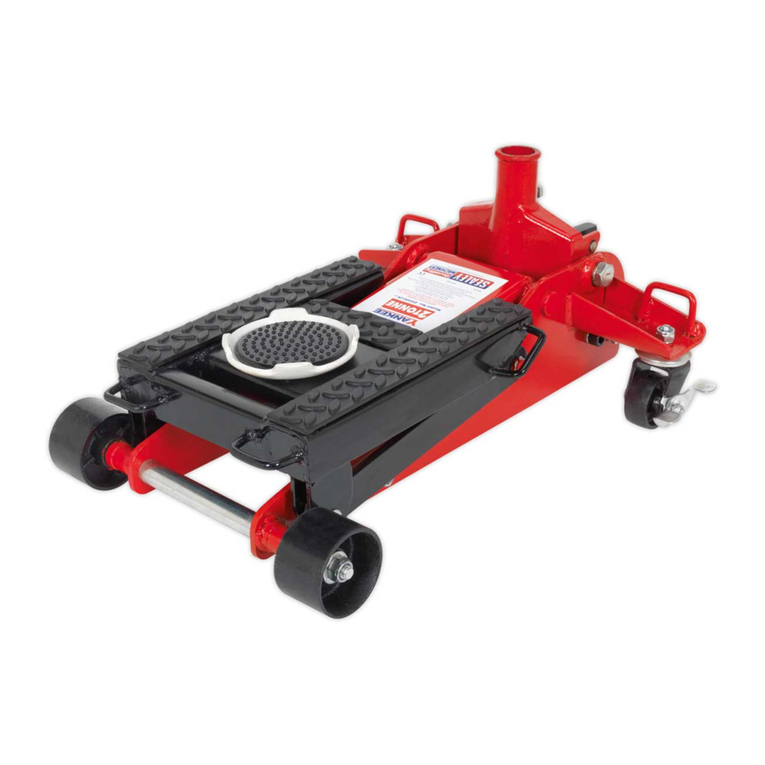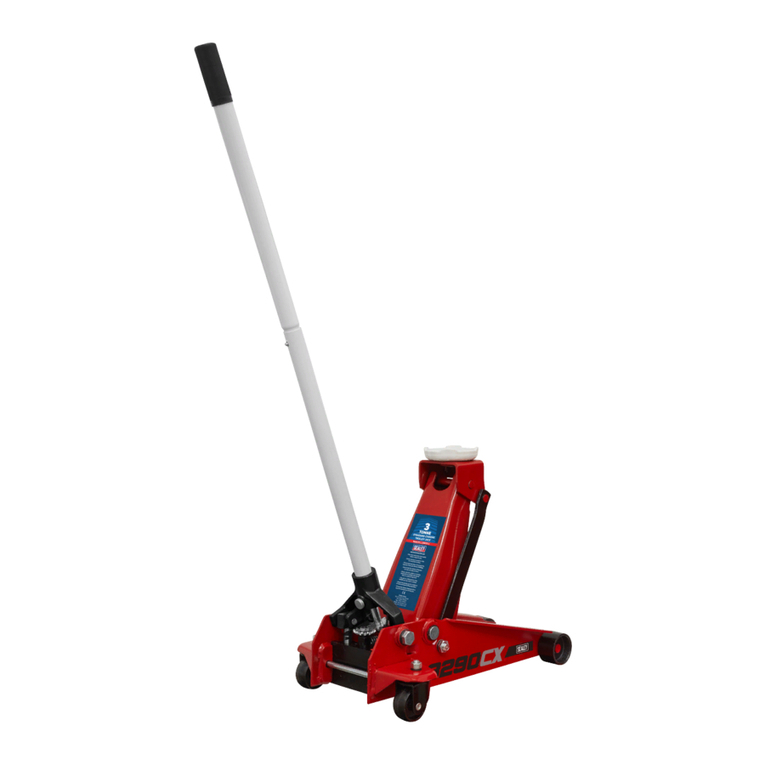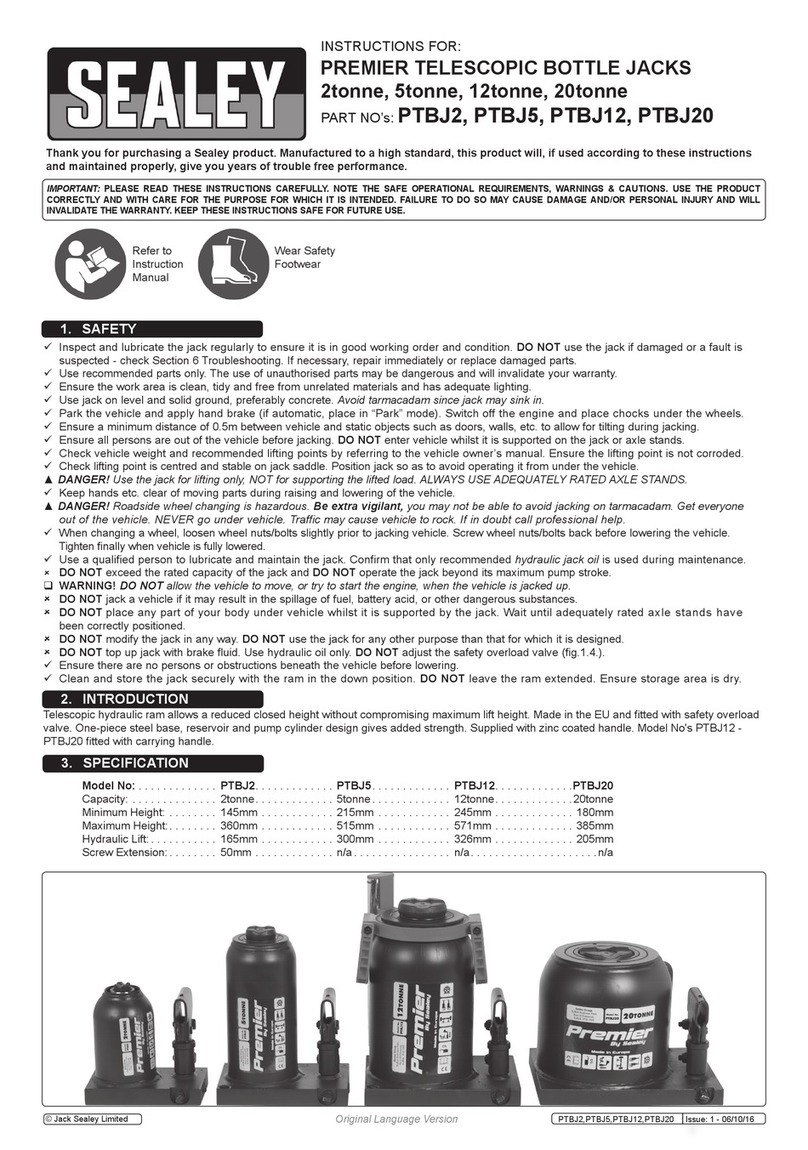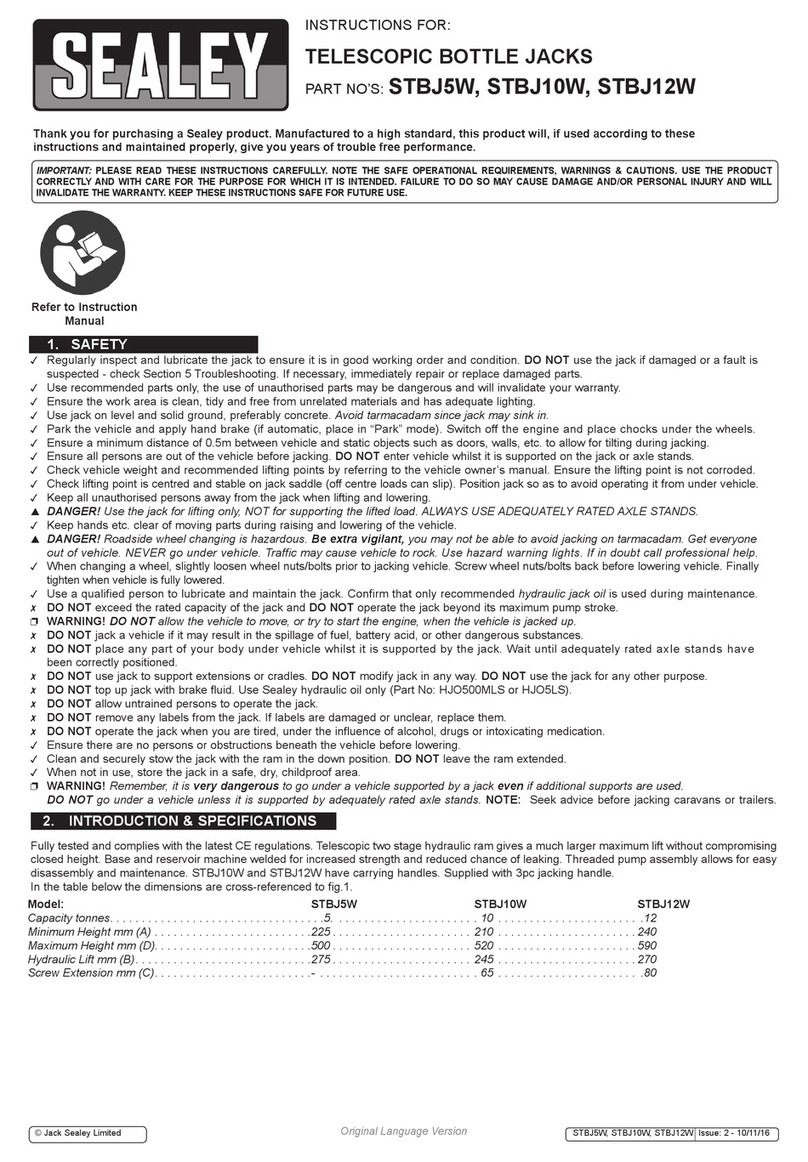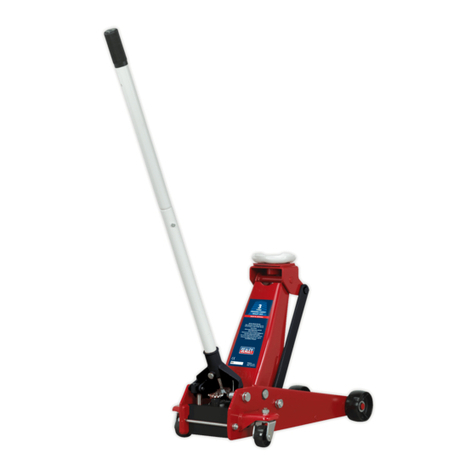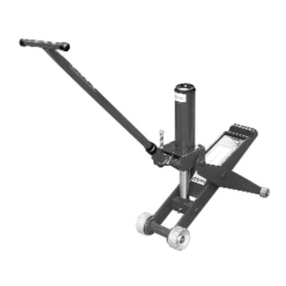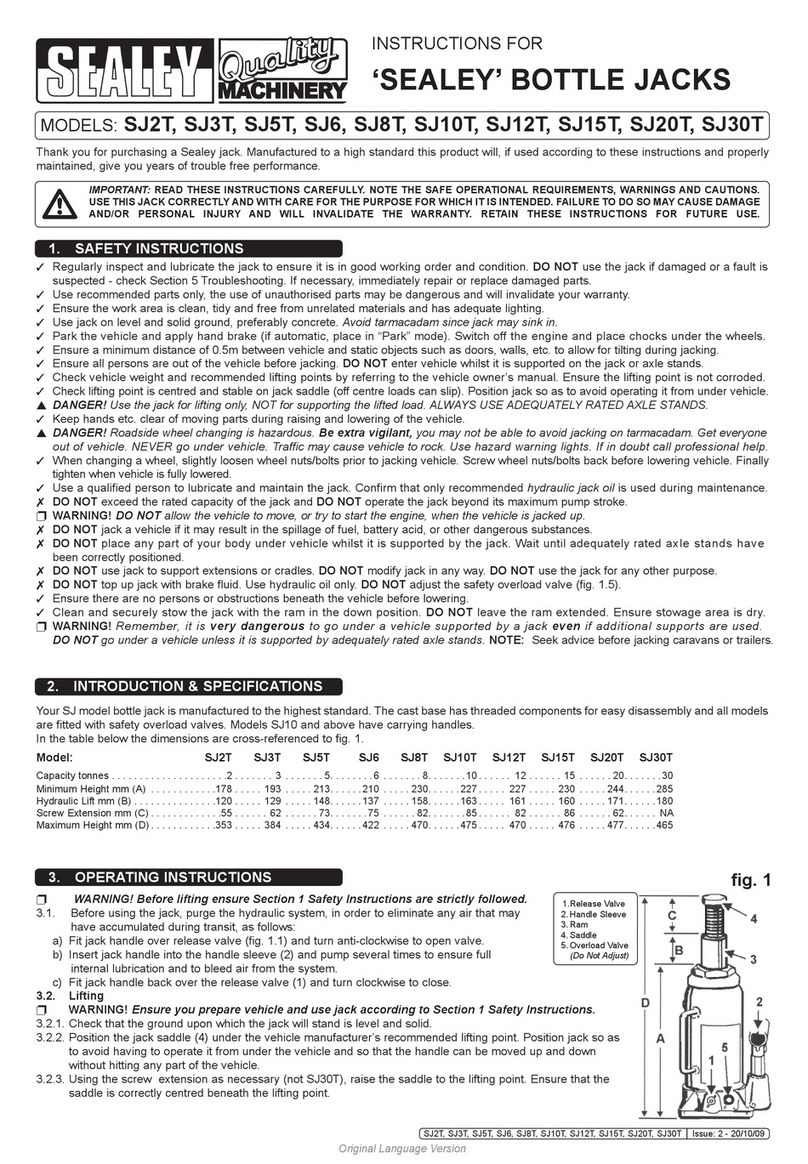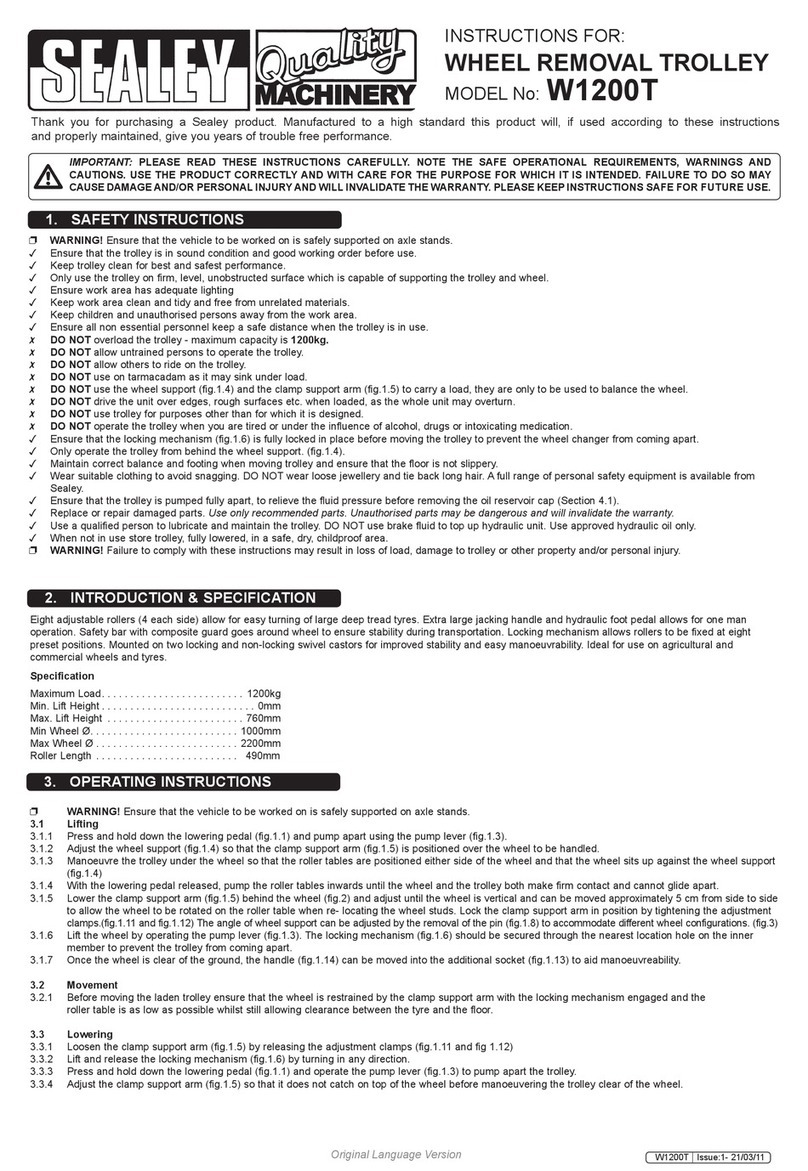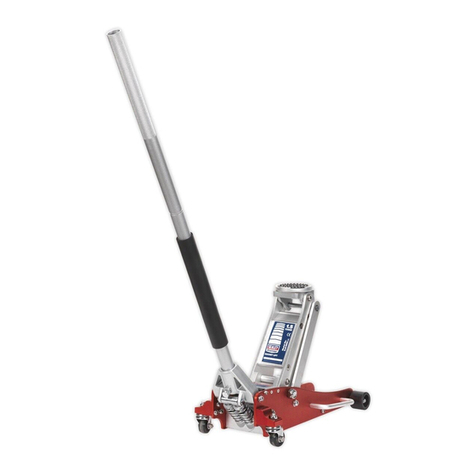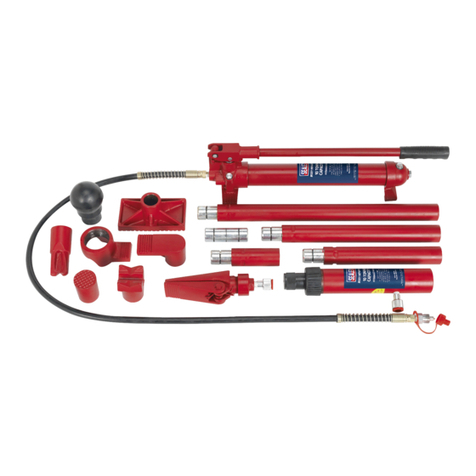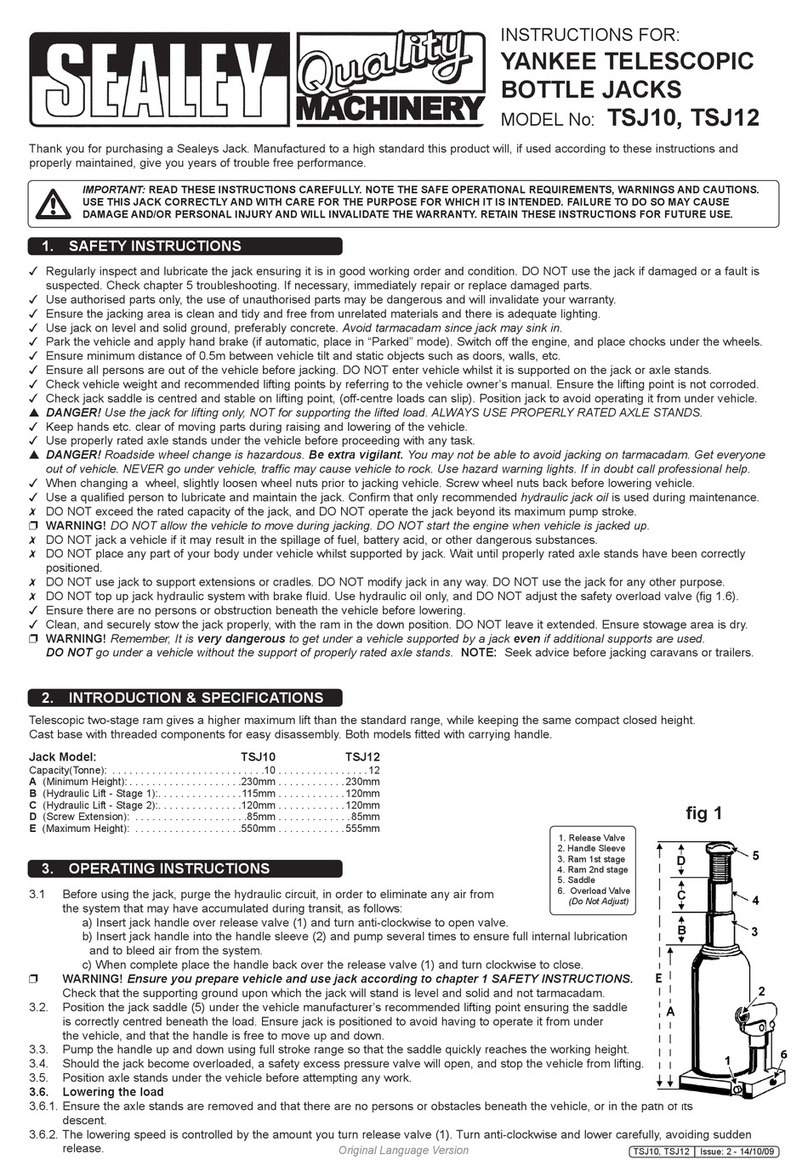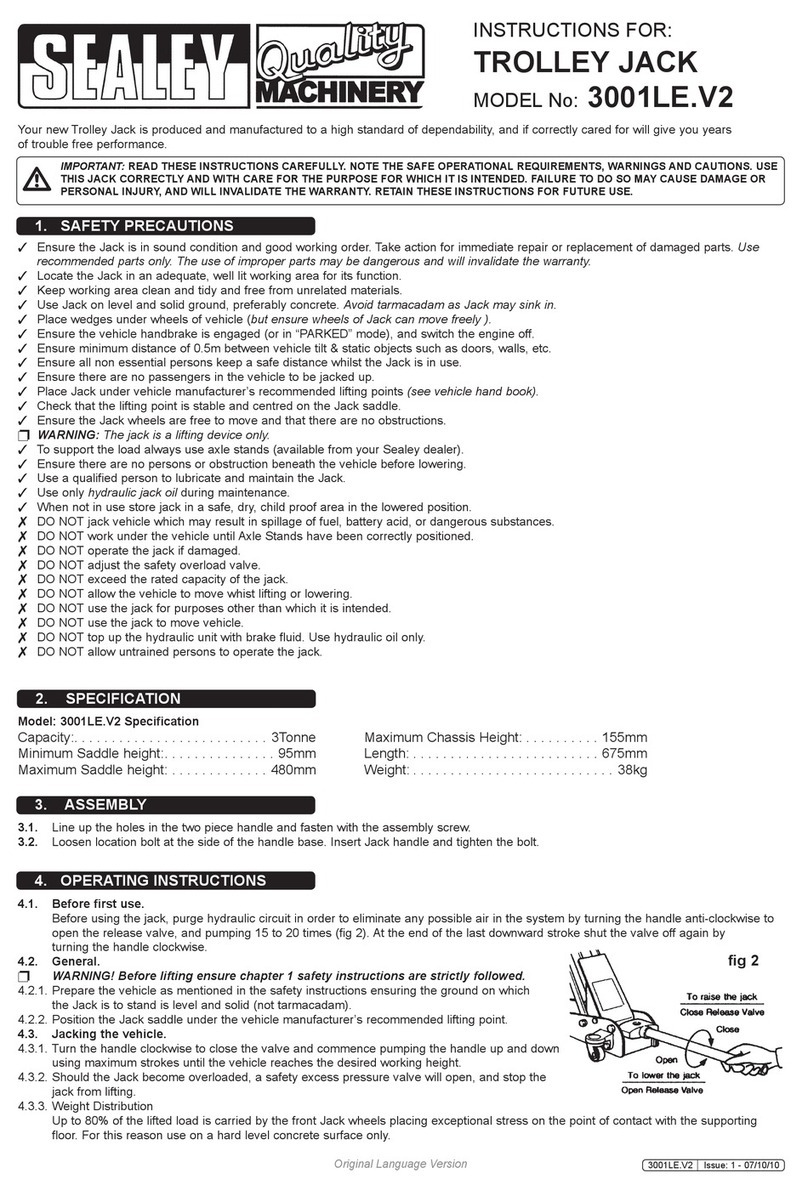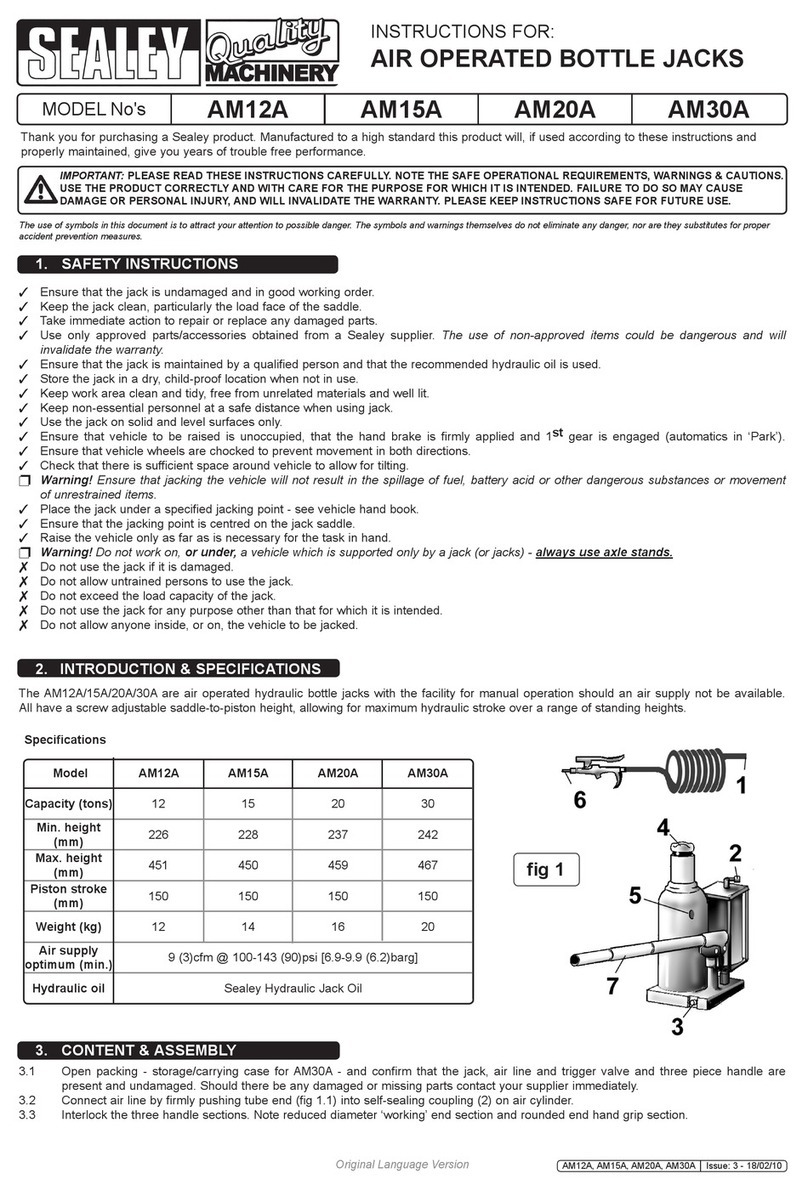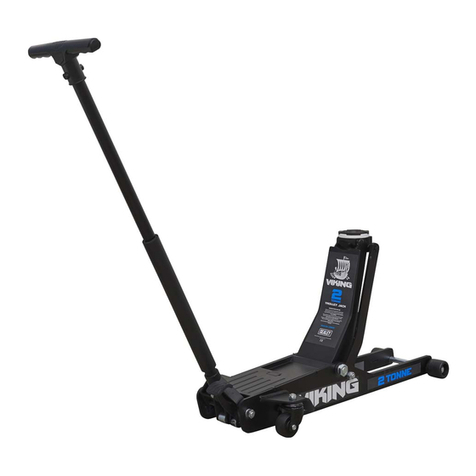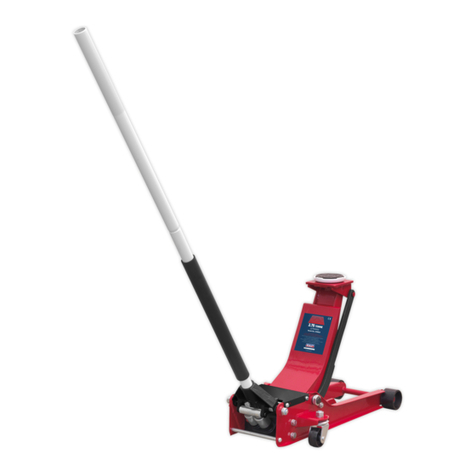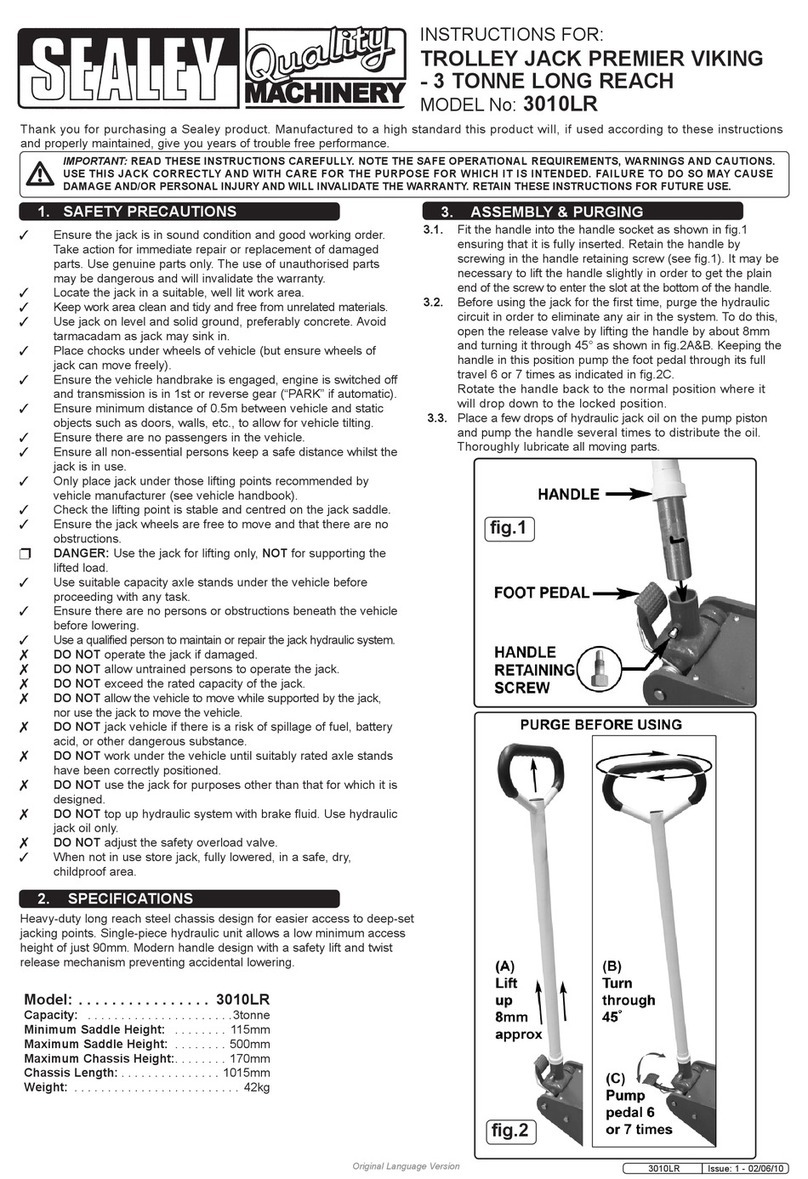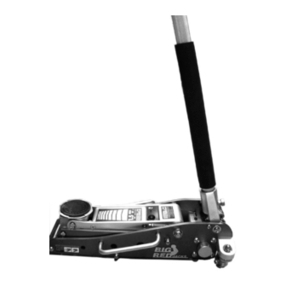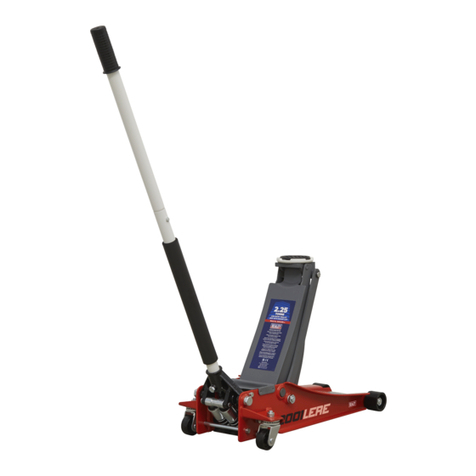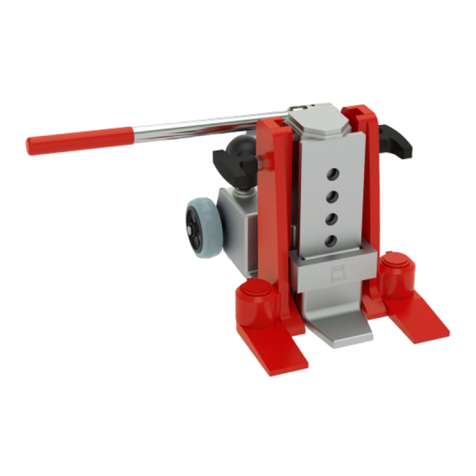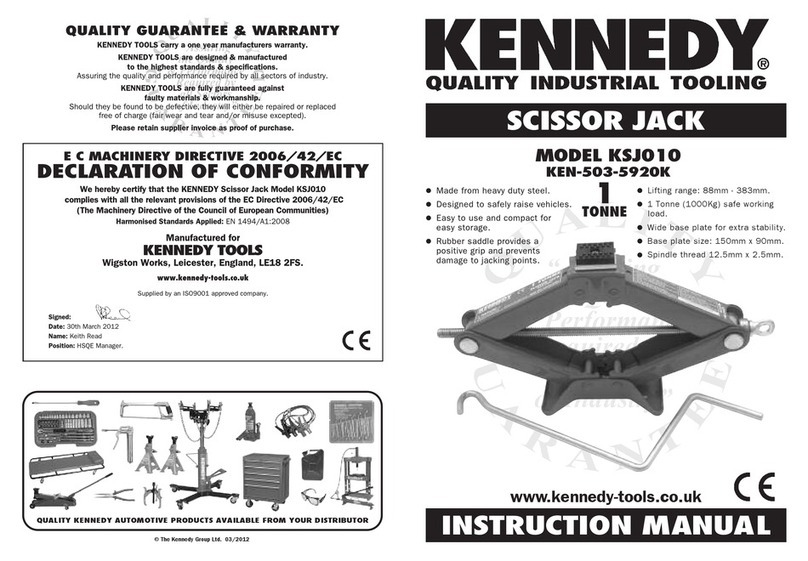
INSTRUCTIONS FOR:
TROLLEY JACK
MODEL NO: 20QJ
3.1. Fit handle by pushing it into the clamp and turning the
handle until the key engages with the release valve rod.
Tighten the clamp bolt. Make sure the locking lever is turned to
engage in the top of the three holes to keep the handle in
the vertical position. See fig.1.
Thank you for purchasing a Sealey product. Manufactured to a high standard this product will, if used according to these instructions
and properly maintained, give you years of trouble free performance.
IMPORTANT: READ THESE INSTRUCTIONS CAREFULLY. NOTE THE SAFE OPERATIONAL REQUIREMENTS, WARNINGS AND CAUTIONS.
USE THIS JACK CORRECTLY AND WITH CARE FOR THE PURPOSE FOR WHICH IT IS INTENDED. FAILURE TO DO SO MAY CAUSE
DAMAGE AND/OR PERSONAL INJURY AND WILL INVALIDATE THE WARRANTY. RETAIN THESE INSTRUCTIONS FOR FUTURE USE.
1. SAFETY PRECAUTIONS
3. ASSEMBLY & PURGING
2. SPECIFICATIONS
Model No: ........................................... 20QJ
Capacity: ....................................... 20tonne
Minimum Saddle Height: ...............190mm
Maximum Saddle Height:...............610mm
Maximum Chassis Height:.............300mm
Length: ..........................................1800mm
Weight: ..............................................280kg
4. OPERATING INSTRUCTIONS
4.1. General jacking.
Refer to figs.1 & 2
NOTE: Locking lever must be in the upper (jacking)
position before handle can be pumped. Ensure that it is left
in the locked position afterwards.
pWARNING! Before lifting, ensure Section 1 safety
instructions are strictly followed.
4.1.1. Prepare vehicle as described in safety instructions ensuring
the ground on which jack is to stand is level and solid (not
tarmacadam). We recommend concrete.
4.1.2. Position the jack saddle under the vehicle manufacturer’s
recommended lifting point (see vehicle handbook).
4.2.Raising the jack.
NOTE: The jack saddle may be raised quickly up to the
load using the foot pedal.
DO NOT attempt to raise the load with the foot pedal.
4.2.1. Turn the release valve handle clockwise until resistance is
felt to close the release valve. DO NOTovertighten.
4.2.2. Place the jack directly under the object to be lifted. Make
sure the saddle accepts weight firmly and centrally. Check
positioning under slight load to confirm jack or load will not
slip, or move suddenly.
4.2.3. Raise jack by moving locking lever to the jacking position
pump handle until the desired height is reached. After
lifting, secure and transfer load to axle stands or other
appropriate means. Do not use jack as the only means of
support.
4.3 Lowering the jack.
4.3.1. Slowly turn the release valve handle anticlockwise. Speed
of descent is controlled by amount release valve is turned.
pSAFETY WARNING! Always lower in a slow and controlled
manner and ensure that there are no persons or obstacles
beneath the vehicle, or in the path of descent.
3Ensure the jack is in sound condition and good working order.
Take action for immediate repair or replacement of damaged parts.
Use genuine parts only. The use of unauthorised parts may be
dangerous and will invalidate the warranty.
3Locate the jack in a suitable, well lit work area.
3Keep work area clean and tidy and free from unrelated materials.
3Use jack on level and solid ground, preferably concrete. Avoid
tarmacadam as jack may sink in.
3Place wedges under wheels of vehicle (but ensure wheels of jack
can move freely).
3Ensure the vehicle handbrake is engaged, engine is switched off
and transmission is in 1st or reverse gear (“PARK” if automatic).
3Ensure minimum distance of 0.5m between vehicle and static
objects such as doors, walls, etc., to allow for vehicle tilting.
3Ensure there are no passengers in the vehicle.
3Ensure all non-essential persons keep a safe distance whilst the
jack is in use.
3Only place jack under those lifting points recommended by vehicle
manufacturer (see vehicle handbook).
3Check the lifting point is stable and centred on the jack saddle.
3Ensure the jack wheels are free to move and that there are no
obstructions.
pDANGER: Use the jack for lifting only, NOT for supporting the
lifted load.
3Use suitable capacity axle stands under the vehicle before
proceeding with any task.
3Ensure there are no persons or obstructions beneath the vehicle
before lowering.
3Use a qualified person to maintain or repair the jack hydraulic system.
7DO NOT operate the jack if damaged.
7DO NOT allow untrained persons to operate the jack.
7DO NOT exceed the rated capacity of the jack.
7DO NOT allow the vehicle to move while supported by the jack, nor
use the jack to move the vehicle.
7DO NOT jack vehicle if there is a risk of spillage of fuel, battery
acid, or other dangerous substance.
7DO NOT work under the vehicle until axle stands have been
correctly positioned.
7DO NOT use the jack for purposes other than that for which it is
designed.
7DO NOT top up hydraulic system with brake fluid. Use hydraulic
jack oil only.
7DO NOT adjust the safety overload valve.
3When not in use store jack, fully lowered, in a safe, dry, childproof
area.
Original Language Version 20QJ Issue: 1 - 26/04/13
g.1
© Jack Sealey Limited
3.2 Before initial operation, purge any air from the system by
fully opening the pump release valve (turn release valve
handle anticlockwise). Then, while holding the saddle
down, pump the handle rapidly several times.
3.3. Place a few drops of hydraulic jack oil on the pump piston
and pump the handle several times to distribute the oil.
Thoroughly lubricate all moving parts.
